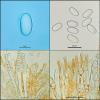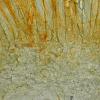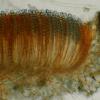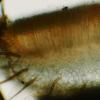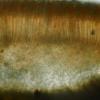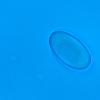
09-11-2025 13:20
Hello.A tiny ascomycete, appearing as erupting gra

08-11-2025 00:29
 Francois Guay
Francois Guay
I found this species in Quebec, Canada, on herbace

04-11-2025 09:07
Hello.A suspected Hymenoscyphus sprouting on a thi

04-11-2025 12:43
 Edvin Johannesen
Edvin Johannesen
Hi! One more found on old Populus tremula log in O

03-11-2025 21:34
 Edvin Johannesen
Edvin Johannesen
These tiny (0.4-0.5 mm diam.), whitish, short-stip
Cheilymenia on moose dung
Juuso Äikäs,
08-05-2023 11:11
The hairs are max. 650 µm long and many are forked at the base. No stellate hairs. The spores are completely smooth in water and cotton blue. Measurements:
(19.2) 19.8 - 21.3 (21.6) × (10) 10.4 - 11.3 (11.5) µm
Q = (1.7) 1.8 - 2 ; N = 20
Me = 20.4 × 10.8 µm ; Qe = 1.9
Although it apparently usually grows on cow dung, could this be C. fimicola?
Juuso Äikäs,
09-05-2023 19:33
Juuso Äikäs,
10-05-2023 17:19
Re : Cheilymenia on moose dung
I managed to make a better section, and the extal excipulum is made of large (up to 80 µm) globose - angular cells, and the medulla seems like an unclear textura intricata. There doesn't seem to be a well-defined subhymenium. Hymenium 285 µm thick. Also, the spores appear to have a loosening perispore in heated CB.
Aside from the large spores and thick hymenium, this would seem to still fit C. coprinaria.
Aside from the large spores and thick hymenium, this would seem to still fit C. coprinaria.
Michel Delpont,
10-05-2023 20:14

Re : Cheilymenia on moose dung
Good evening.
Indeed the spores are a little different in size, but despite everything I think you are in the right direction with C.coprinaria. Difficult to disentangle sometimes according to the authors the various authors.
Michel.
Juuso Äikäs,
10-05-2023 20:25
Re : Cheilymenia on moose dung
Good evening Michel, and thank you for the assesment! I think this is what I will label this.


